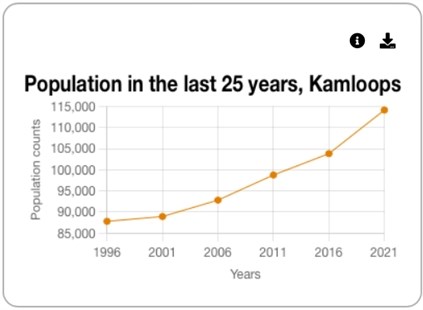
Image Credit: File photo
February 17, 2022 - 6:00 AM
While most people know their home is in a city, town or village, Statistics Canada goes much further in categorizing population areas. On the top of the classification pyramid, just below country and province, is the Census Metropolitan Area (CMA) classification that Kamloops has now joined.
That means a multitude of data, from how lawn watering is done to unemployment rates, will now include a column for the Kamloops CMA.
When the 2021 Census released its population data last week, it added six new CMAs so there are now 41 in Canada within which almost three-quarters of Canadians live.
These areas range in size from Toronto with more than six million residents all the way down to the 100,844 people in the new Red Deer CMA.
It’s important to make the distinction between Kamloops and the Kamloops Census Metropolitan Area.
Kamloops had a population of 97,902 on the official census date of May 11, 2021 and grew by 8.4% over the five-year census period.
But the Kamloops CMA had 114,142 people with a 10% population growth rate over the same time. That meant it was tied with London, Ontario, and Nanaimo as the third fastest growing CMA in Canada.
Kelowna was number one on that list at 14% with Chilliwack number two at 12.1%. Chilliwack and Nanaimo joined Kamloops as the three B.C. CMA’s that were added to the list.
READ MORE: Kelowna, Kamloops among three fastest-growing larger cities in Canada, new census data shows
There are seven CMAs in B.C. In addition to the four named above, there’s Vancouver, Victoria and Abbotsford-Mission.
What is a CMA?
Statistics Canada has a lengthy definition but, essentially, it’s one or more adjacent communities centred on a core population centre totalling more than 100,000 people.

Population growth of Kamloops Census Market Area from 1996 to 2021.
Image Credit: SUBMITTED/Statistics Canada
The core city has to have at least 50,000 people and the neighbouring communities must “have a high degree of integration with the core, as measured by commuting flows.”
With Kamloops at its core, its Census Market Area includes Chase (population 2,399), Logan Lake (2,255) and Sun Peaks (1,404).
There are three Indian Reserves: Kamloops 1 (3,915 residents) Sahhaltkum 4 (316) and Whispering Pines 4 (57) along with Areas P (Rivers and the Peaks with 4,098 people) and J (Copper Desert Country with 1,796 residents) of the Thompson-Nicola Regional District.
The Kelowna Census Metropolitan Area includes the entire Regional District of Central Okanagan.
What does this mean for people who live in what can now be called Greater Kamloops?
On the surface, nothing much. They go on with their existing levels of government and people go about their business as normal.
But, for those who love to mine data, it opens up a whole new world of Statistics Canada data pages.
Along with things like regular reporting of vacancy rates, employment numbers, gross domestic product and crime severity, there’s a wealth of other data that’s broken out for Census Metropolitan Areas but not for smaller cities or towns.
In 2019, for example, Statistics Canada did a report on outdoor water use that found that 79% of homes in the Kelowna CMA had lawns and 83% of those used a timer on their sprinklers or sprinkler systems. By contract, 78% of homes in the Abbotsford-Mission CMA had lawns but that data on timers was not reliable enough to post.
Another report on data from the 2016 census found that 4.9% of Kelowna CMA residents identified as First Nations while an equal number identified as Metis.
A third study found that 1.2% of school age children (5 to 24) in the Kelowna CMA had a non-official home language. That compared to 6.1% for Abbotsford-Mission.
One page on the Statistics Canada website lists 629 reports with Census Metropolitan Area in their titles. That doesn't mean that Kamloops now qualifies for all those kinds of report since some include only a few of the largest CMAs and others include smaller city classifications called Census Agglomerations where the core city has to have at least 10,000 residents.
The problem for Kamloops is all those reports were in the past. It's such a new CMA to this elevated status that very little, other than the population of the area, is yet available, but stay tuned. One key element of Census Metropolitan Area is that, once an area meets that definition, it will remain, even if their population falls below the established thresholds.
For more information on the Kamloops Census Metropolitan Area go here.
To contact a reporter for this story, email Rob Munro or call 250-808-0143 or email the editor. You can also submit photos, videos or news tips to the newsroom and be entered to win a monthly prize draw.
We welcome your comments and opinions on our stories but play nice. We won't censor or delete comments unless they contain off-topic statements or links, unnecessary vulgarity, false facts, spam or obviously fake profiles. If you have any concerns about what you see in comments, email the editor in the link above.
News from © iNFOnews, 2022